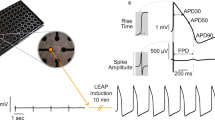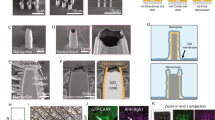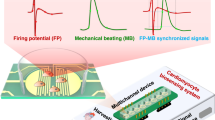Abstract
Microelectrode arrays (MEAs) with evenly distributed multiple sensor spots have been designed for specific applications. Using the MEAs, we determined the relative profiles of potassium channel openers (KCOs) on cultured embryonic Sprague-Dawley rat cardiac myocytes. KCO, pinacidil (PIN), cromakalim (CROM), SDZ PCO400 (SDZ), or its vehicle, was added to the myocytes cumulatively. The action potential signal shapes in the presence of PIN and SDZ show that the changes in voltage over time and the magnitudes of the associated voltage change were reduced concentration-dependently. CROM affected sodium influx more than PIN and SDZ. The comparisons of changes in the rate of beating and propagation speed in the presence of KCOs were made using their corresponding pD2 values (the negative log of EC50). All KCOs caused concentration-dependent reductions in the rate of beating and propagation speed, with SDZ being the most potent. In addition to the signal shapes, rate of beating, and propagation speed, the origin of excitation and the excitation pattern inside the culture can be also extracted. The results show that the present system can differentiate the effects of different KCOs on myocytes. It might be possible to utilise the MEA as a means to classify drug action based upon a combined interpretation of the three different datasets gained from the extracellular recordings. The combination of these observations might be used as ‘drug signatures’ when profiling drugs in the future.




Similar content being viewed by others
References
Gross GW, Rhoades BK, Azzazy HME, Ming-Chi W (1995) Biosens Bioelectron 10:553–567
Jahnsen H, Kristensen BW, Thiebaud P, Noraberg J, Jakobsen B, Bove M, Martinoia S, Koudelka-Hep M, Grattarola M, Zimmer J (1999) Methods 18:160–172
Maher MP, Pine J, Wright J, Tai YC (1999) J Neurosci Methods 87:45–56
Claverol-Tinture E, Ghirardi M, Fiumara F, Rosell X, Cabestany J (2005) J Neural Eng 2:L1–L7
Denyer MCT, Riehle M, Britland ST, Offenhäusser A (1998) Med Biol Eng Comput 36:638–644
Ecken H, Ingebrandt S, Krause M, Richter D, Hara M, Offenhäusser A (2003) Electrochim Acta 48:3355–3362
Rothermel A, Kurz R, Ruffer M, Weigel W, Jahnke HG, Sedello AK, Stepan H, Faber R, Schulze-Forster K, Robitzki AA (2005) Cell Physiol Biochem 16:51–58
Pancrazio JJ, Whelan JP, Borkholder DA, Ma W, Stenger DA (1999) Ann Biomed Eng 27:697–711
Stett A, Egert U, Guenther E, Hofmann F, Meyer T, Nisch W, Haemmerle H (2003) Anal Bioanal Chem 377:486–495
Ingebrandt S, Yeung CK, Krause M, Offenhäusser A (2001) Biosens Bioelectron 16:565–570
Yeung CK, Ingebrandt S, Krause M, Offenhäusser A, Knoll W (2001) J Pharmacol Toxicol Methods 45:207–214
Ingebrandt S, Yeung CK, Staab W, Zetterer T, Offenhäusser A (2003) Biosens Bioelectron 18:429–435
Krause M, Ingebrandt S, Richter D, Denyer M, Scholl M, Sprössler C, Offenhäusser A (2000) Sens Actuators B 70:101–107
Wrobel G, Zhang Y, Krause H-J, Wolters N, Sommerhage F, Offenhäusser A, Ingebrandt S (2007) Biosens Bioelectron 22:1092–1096
Reppel M, Pillekamp F, Lu ZJ, Halbach M, Brockmeier K, Fleischmann BK, Hescheler J (2004) J Electrocardiol 37:104–109
Löffler-Walz C, Quast U (1998) Br J Pharmacol 123:1395–1402
Noma A (1993) Cardiovasc Drug Ther 7:515–520
Seino S, Miki T (2003) Prog Biophys Mol Biol 81:133–176
Gross GJ, Peart JN (2003) Am J Physiol Heart Circ Physiol 285:H921–H930
Duncker DJ, Verdouw PD (2000) Cardiovasc Drug Ther 14:7–16
Kinoshita H, Hatano Y (2004) Curr Med Chem Cardiovasc Hematol Agents 2:99–106
Das B, Sarkar C (2005) Life Sci 77:1226–1248
Kloner RA, Rezkalla SH (2004) J Am Coll Cardiol 44:276–286
Miura T, Miki T (2003) Curr Vasc Pharmacol 1:251–258
Kicinska A, Szewczyk A (2003) Gen Physiol Biophys 22:383–395
Lathrop DA, Contney SJ, Bosnjak ZJ, Stowe DF (1998) Gen Pharmacol 31:125–131
Mannhold R (2004) Med Res Rev 24:213–266
Pollesello P, Mebazaa A (2004) Curr Opin Crit Care 10:436–441
Tamargo J, Caballero R, Gomez R, Valenzuela C, Delpon E (2004) Cardiovasc Res 62:9–33
Jahangir A, Terzic A (2005) J Mol Cell Cardiol 39:99–112
Meyburg S, Goryll M, Moers J, Ingebrandt S, Böcker-Meffert S, Lüth H, Offenhäusser A (2006) Biosens Bioelectron 21:1037–1044
Krause M (2000) Untersuchungen zur Zell-Transistor Kopplung mittels der Voltage-Clamp Technik. PhD thesis, Johannes Gutenberg Universität Mainz, Mainz, http://archimed.uni-mainz.de
Zhang Y, Wrobel G, Wolters N, Ingebrandt S, Krause HJ, Otto R (2005) Device for the non-invasive measurement of cell signals. Patent WO002006050683A1, 15 Nov 2005
Halbach MD, Egert U, Hescheler J, Banach K (2003) Cell Physiol Biochem 13:271–284
Sprössler C, Denyer M, Britland S, Curtis A, Knoll W, Offenhäusser A (1999) Phys Rev E 60:2171–2176
Banach K, Halbach MD, Hu P, Hescheler J, Egert U (2003) Am J Physiol Heart Circul Physiol 284:H2114–H2123
Egashira K, Nishii K, Nakamura KI, Kumai M, Morimoto S, Shibata Y (2004) Anat Rec Part A 280A:973–979
Meiry G, Reisner Y, Feld Y, Goldberg S, Rosen M, Ziv N, Binah O (2001) J Cardiovasc Electrophysiol 12:1269–1277
Eun JS, Park JA, Choi BH, Cho SK, Kim DK, Kwak YG (2005) Biol Pharm Bull 28:657–660
Pillekamp F, Reppel M, Dinkelacker V, Duan YQ, Jazmati N, Bloch W, Brockmeier K, Hescheler J, Fleischmann BK, Koehling R (2005) Cell Physiol Biochem 16:127–132
Zhu G, Okada M, Murakami T, Kamata A, Kawata Y, Wada K, Kaneko S (2000) Neurosci Lett 294:53–57
Acknowledgements
This work was supported by an Earmarked Grant from the Research Grant Council of Hong Kong under contract no. 611205 and the Helmholtz Association of National Research Centres, Germany. The authors would like to thank N. Wolters (IBN-2, Electronic Workshop) and Y. Zhang (IBN-2) for their technical expertise in designing the current MEA system and M. Schindler (IBN-2) for the bandwidth characterisation. MEA chips were fabricated by M. Krause in a previous project at the Max Planck Institute for Polymer Research, Mainz, Germany within the group of W. Knoll.
Author information
Authors and Affiliations
Corresponding author
Electronic supplementary material
Below is the link to the electronic supplementary material.
Rights and permissions
About this article
Cite this article
Yeung, C.K., Sommerhage, F., Wrobel, G. et al. Drug profiling using planar microelectrode arrays. Anal Bioanal Chem 387, 2673–2680 (2007). https://doi.org/10.1007/s00216-007-1172-8
Received:
Revised:
Accepted:
Published:
Issue Date:
DOI: https://doi.org/10.1007/s00216-007-1172-8




